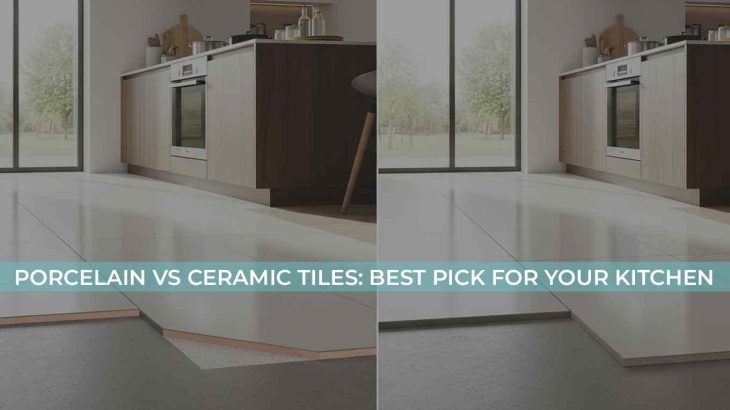You are renovating your kitchen, but don’t know whether to choose porcelain or ceramic? Both options come with their own set of benefits and exceptional features like durability, looks, and design versatility. However, each performs differently under different environments, particularly in UK homes where moisture, foot traffic, and underfloor heating are some of the top considerations.
Whether you are selecting kitchen floor tiles for your busy cooking space or elegance in your kitchen wall tiles, it is very crucial that you understand the difference between porcelain vs ceramic kitchen tiles and make the right investment in the right type of tile.
Difference Between Porcelain and Ceramic Tiles
Before properly comparing porcelain or ceramic tiles for kitchens and their performance, let’s understand porcelain vs ceramic tiles based on their material and features.
Porcelain Tiles
Made from refined clay fired at 1200 °C- 1400 °C, porcelain tiles are denser than ceramic tiles. This process of firing makes them denser, harder, and less porous. This is the reason that they are ideal for kitchens, bathrooms, and outdoor areas. Both of the tiling options resist moisture extremely well, making them perfect for kitchen floors where spills are experienced every now and then.
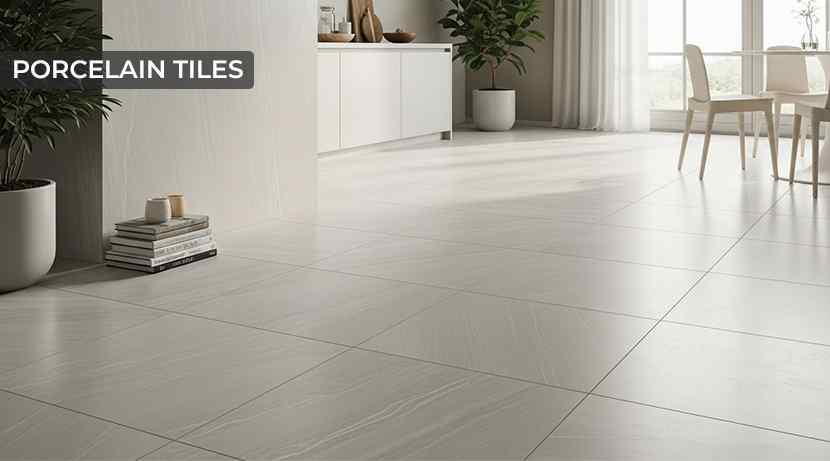
Features of Porcelain Tiles
- Highly durable and long-lasting
- Water resistant.
- Suitable for heavy traffic areas
- You find porcelain in matt, gloss, and textured surfaces
- Compatible floor tiles for underfloor heating
Ceramic Tiles
Ceramic tiles are made from natural clay as well, but at a lower temperature than porcelain. They are slightly softer and porous than porcelain, but still more durable than many options in the market for kitchen walls and splashbacks.
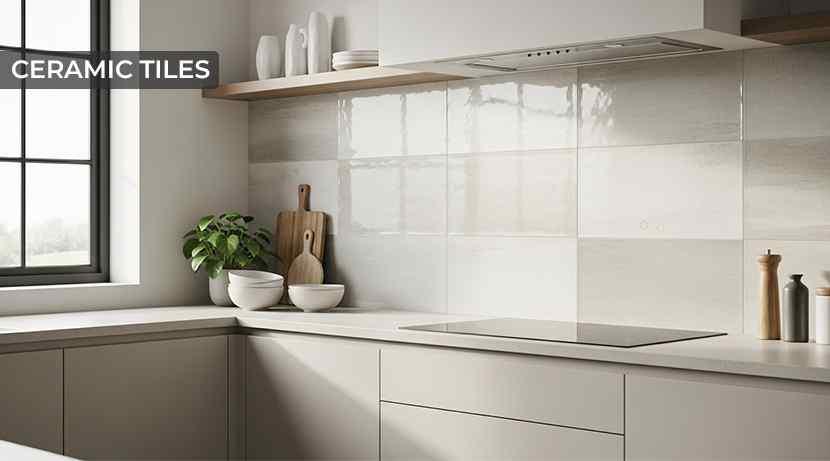
Features of Ceramic Tile
- Easier to cut and install.
- Ideal for kitchen walls.
- You can find them in a variety of colours and finishes.
Ceramic vs Porcelain Tiles: Key Differences
Below, we will compare these two popular kitchen tiles based on performance and suitability for your UK home.
Durability
When it comes to strength, porcelain is a clear winner. It is because porcelain has a higher density and has a very low absorption rate than ceramic. Porcelain is built to handle high-traffic kitchens and even outdoor patios.
Ceramic tiles are, no doubt, sturdy, and they are more suited for medium traffic kitchens and wall applications. They are perfect for vertical spaces but easily chip under pressure or impact.
Water and Stain Resistance
As you know that kitchens are prone to spills, splashes, and humidity. This is where porcelain shows its excellence. They have near-zero porosity, which makes them resistant to liquids and stains.
Ceramic Tiles, on the other hand, are glazed for protection but may still absorb moisture if their glaze is damaged or not fully sealed. Ceramic tiles are better suited for backsplashes than for kitchen floors.
Maintenance and Cleaning
One of the most important aspects of this comparison is maintenance. While both materials are easy to maintain, porcelain is slightly more resistant to stains and scratches.
Porcelain only needs a simple mop with warm and soapy water, while ceramic needs a pH-neutral cleaner and resealing after some time if it is unglazed.
Installation
When it comes to installation, ceramic win the game as they are easier and lighter to cut. They are ideal for DIY projects in your home.
Porcelain tiles are harder to install as they need stronger cutting tools and professionals to handle the job due to their density. However, once you install it professionally, it lasts longer than ceramic. In short, porcelain is a long-term investment and gives your money value well.
Cost Comparison
One of the most commonly asked questions by homeowners is “Which is more expensive, porcelain or ceramic tile?”
Well, porcelain tiles are 10 to 30% more expensive than ceramic tiles. The strength, longevity, and water resistance justify the price difference, though.
If you are opting for large kitchen floor tiles, the upfront cost of porcelain tile may be higher, but the reduced maintenance and lifespan make it a better investment and all worth it.
Where Each Tile Works Best
Deciding between ceramic or porcelain tiles for kitchen walls and kitchen floors? Let us help you.
Porcelain: Kitchen Floors
Porcelain is a wonderful choice for your kitchen floor tiles as they are able to withstand heavy foot traffic, sudden impacts, and moisture very well. Want to know whether to choose porcelain or ceramic tiles for underfloor heating? Porcelain works best with underfloor heating systems as its density allows for heat distribution.
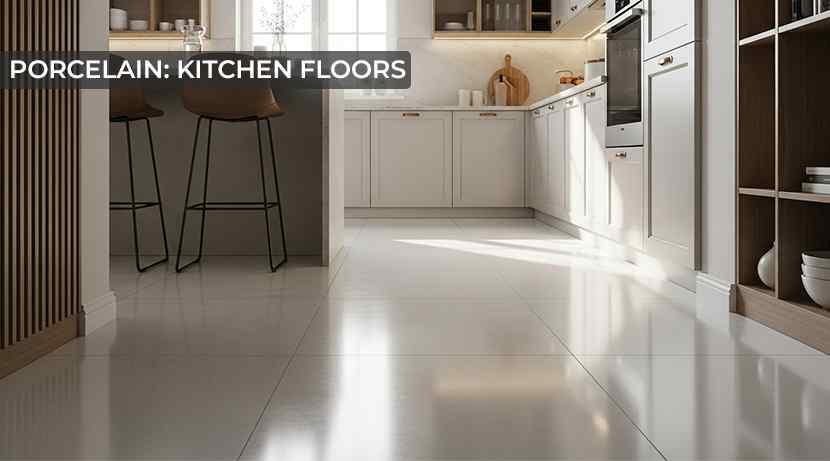
Porcelain is best for:
- Busy and high-traffic family kitchens
- Open plan kitchen systems
- Modern and sleek interiors
Ceramic Tiles: For Kitchen Walls
Ceramic tiles can be best used as kitchen wall tiles or splashbacks. Their lightweight and decorative glazing makes them easier to install in vertical spaces and allows for the wall design.
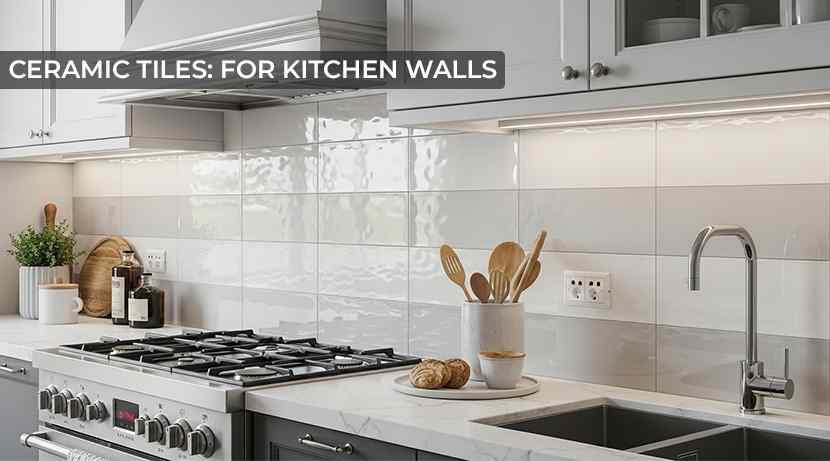
Ceramic is best for:
- Backsplashes behind hobs and sinks
- Feature walls
- Traditional or rustic kitchen styles
Choosing the Right Tile for Your Kitchen Style
When you choose tiles for kitchens, you do not just look at the practicality; you filter out your options based on function as well as beauty. Design matters a lot.
Modern Kitchens
Concrete-effect and stone-effect tiles play a crucial role in creating a sophisticated and urban look. If you want a minimalist kitchen, opt for matte finishes, which are smooth and have excellent foot grip for your kitchen floors.
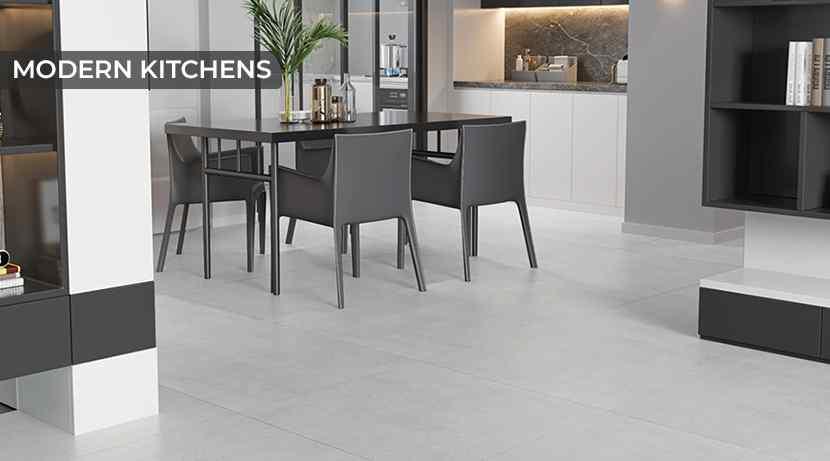
Traditional Kitchens
For a classic kitchen, ceramic tiles with subway or metro patterns are choices that will not only enhance your home’s value but also look great. They reflect light beautifully and pair very well with brass fixtures and neutral cabinets.
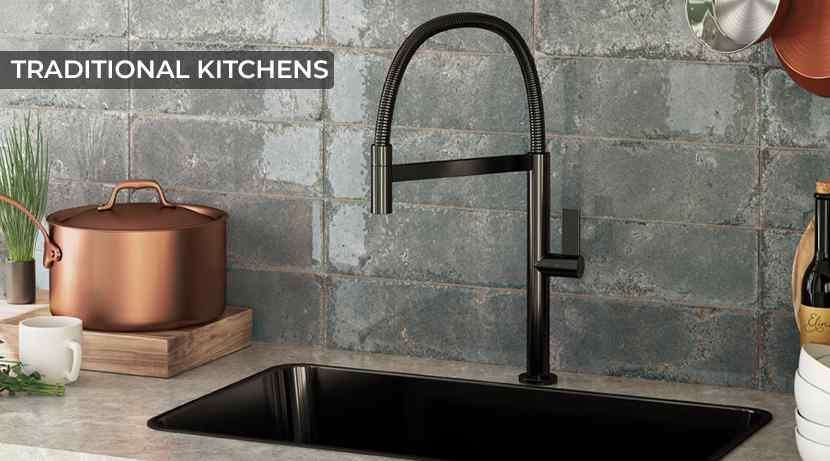
Country or Farmhouse Kitchens
Wood-effect porcelain tiles replicate the warmth of timber without the maintenance of the actual wood. They are highly durable, making them perfect for rustic yet practical kitchen flooring.
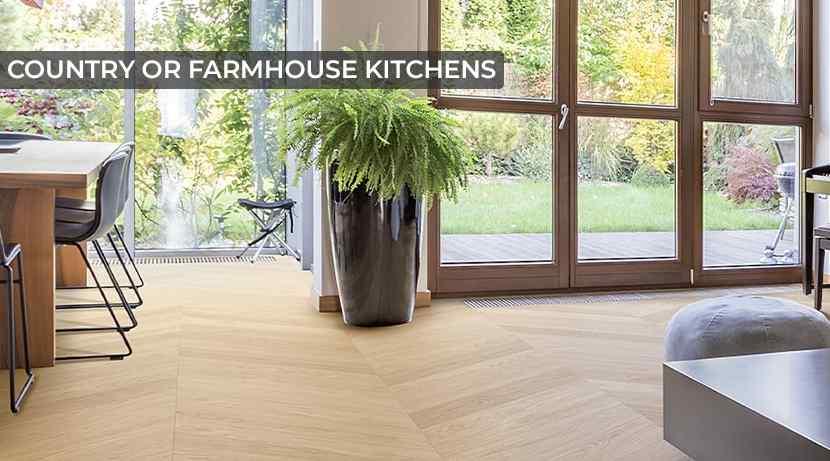
Royale Stones UK: Your Ultimate Tile Expert
If you want to buy kitchen tiles in the UK, Royale Stones offers you their exceptional porcelain tile range suitable for all kitchen designs and budgets. Their collections include non-slip kitchen floor tiles, stylish wall tiles, and underfloor heating compatible options that are ideal for British homes.
They deliver nationwide and give expert advice on all your indoor tiling projects, helping UK homeowners achieve the kitchen of their dreams.
Conclusion
While both porcelain and ceramic offer stunning tiling results for your kitchen renovations, it depends on where you use them.
If you want hard-wearing kitchen floor tiles, choose porcelain as they are accustomed to high traffic areas and open plan spaces. If you want a decorative charm in your kitchen, ceramic tiles used on the walls and as splashbacks are an affordable and durable choice.
Whichever you pick, invest in high-quality tiles from your trusted supplier, Royale Stones, in order to make your kitchen an elegant space where cooking is easy and life is easier!
Conclusion
While both porcelain and ceramic offer stunning tiling results for your kitchen renovations, it depends on where you use them.
If you want hard-wearing kitchen floor tiles, choose porcelain as they are accustomed to high traffic areas and open plan spaces. If you want a decorative charm in your kitchen, ceramic tiles used on the walls and as splashbacks are an affordable and durable choice.
Whichever you pick, invest in high-quality tiles from your trusted supplier, Royale Stones, in order to make your kitchen an elegant space where cooking is easy and life is easier!
